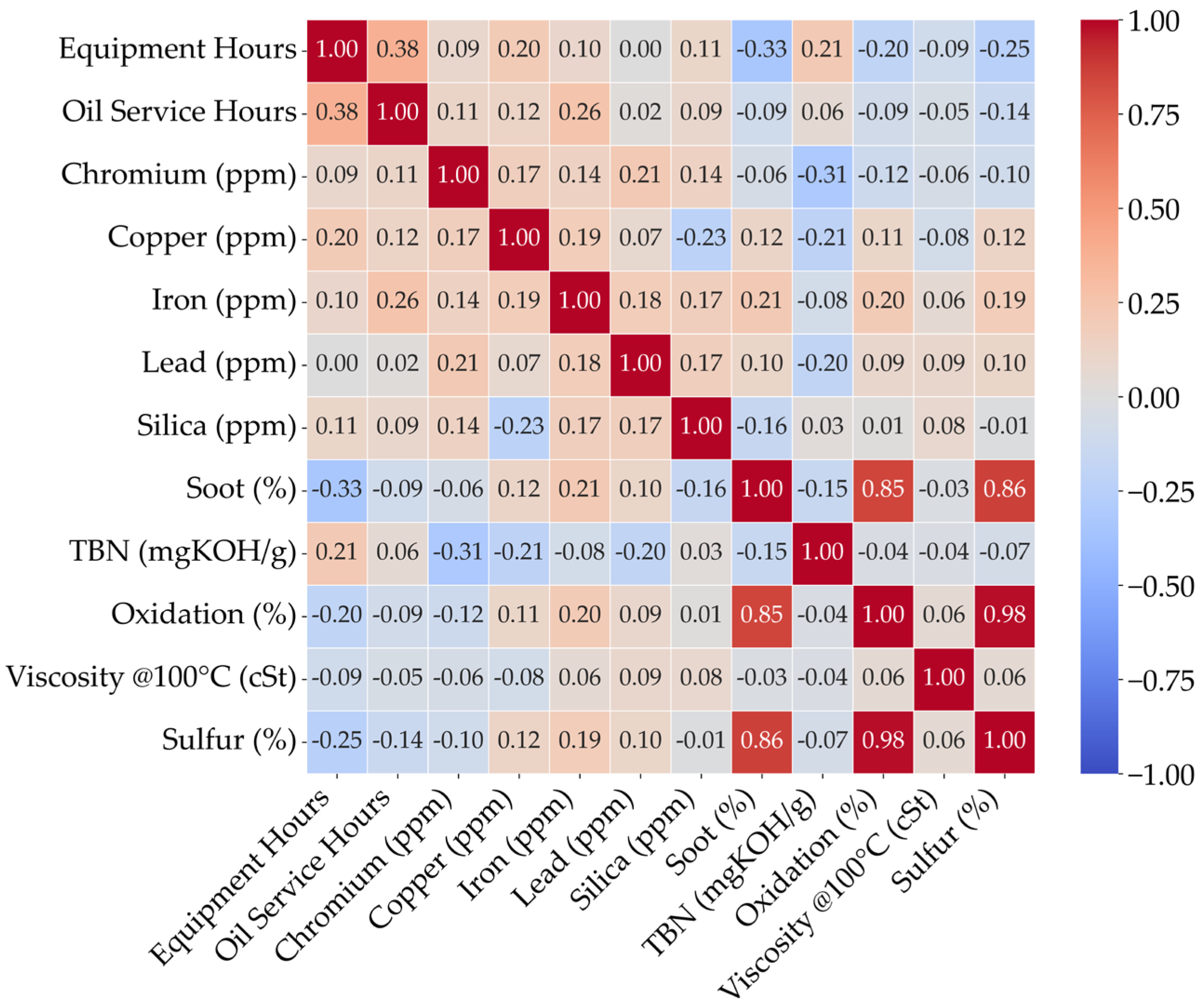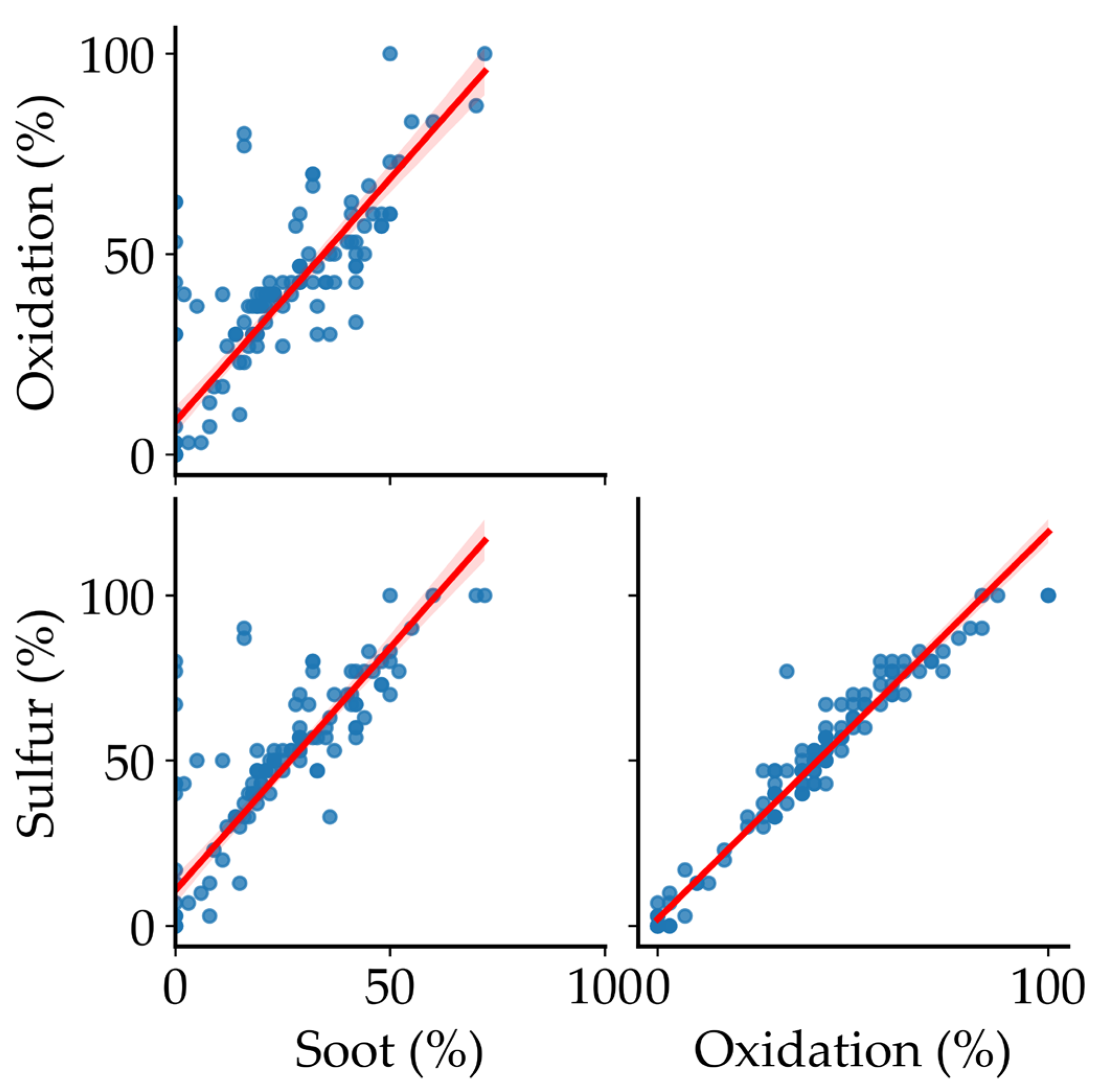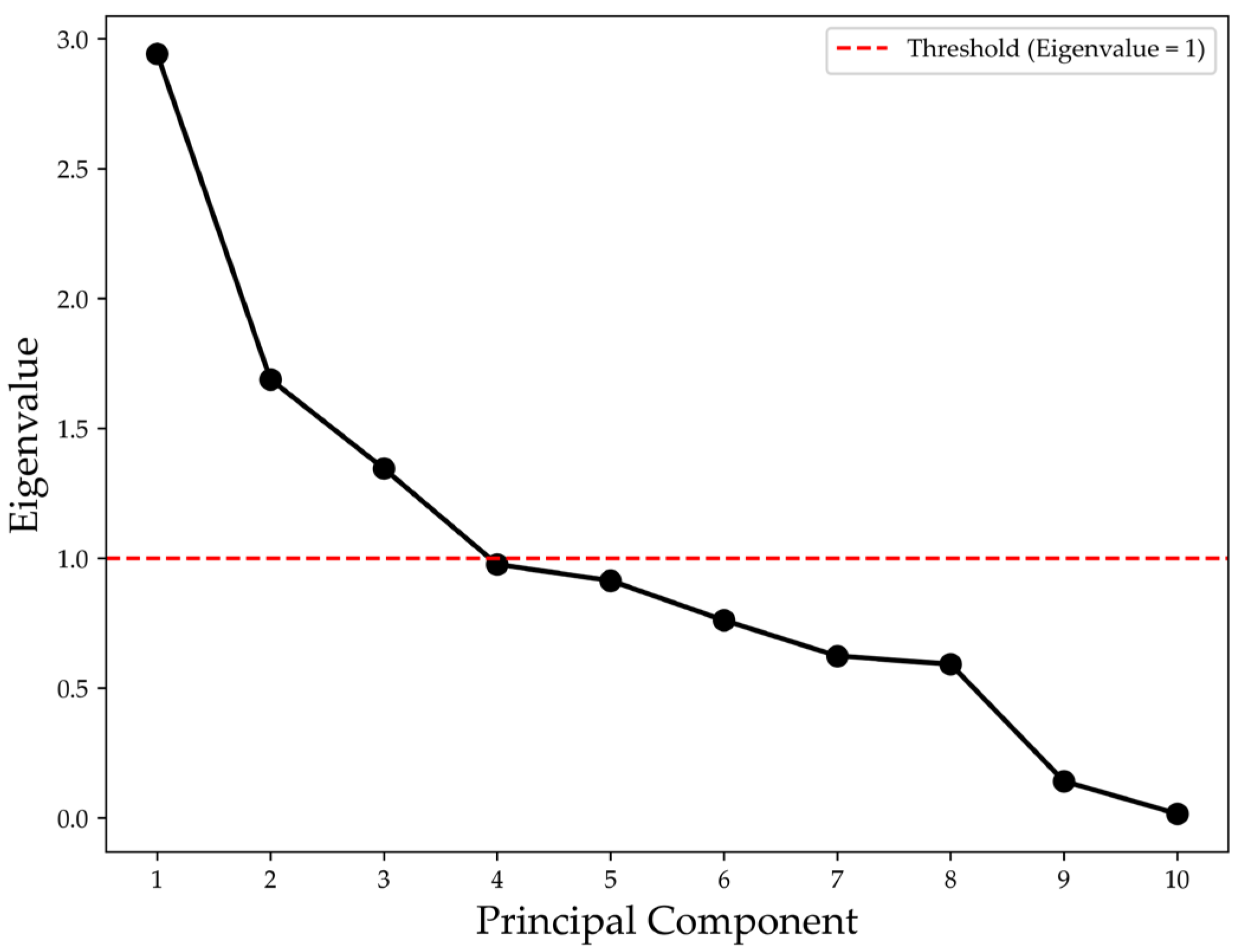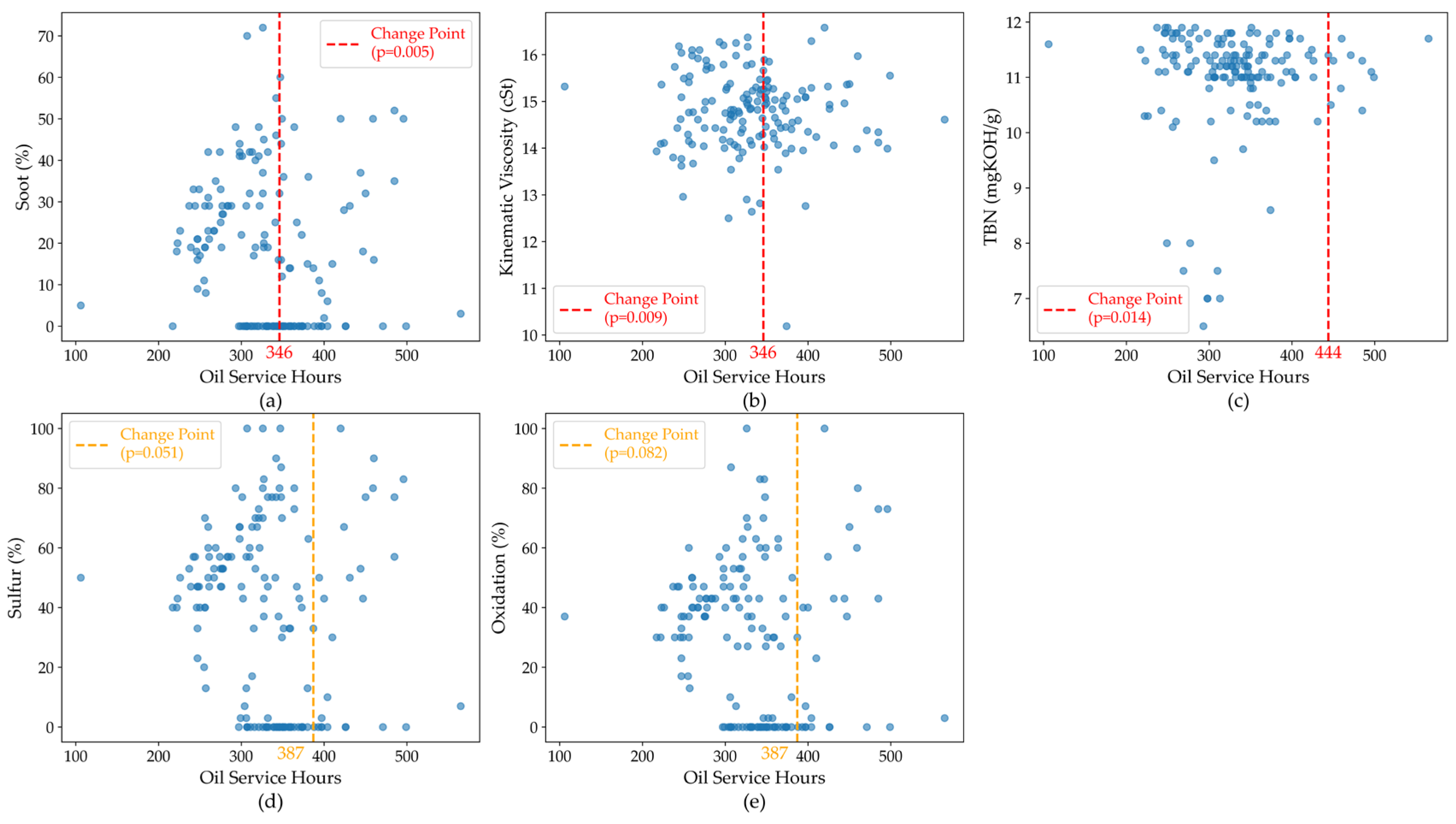An Integrated Methodological Approach for Interpreting Used Oil Analysis in Diesel Engines
Abstract
1. Introduction
2. Materials and Methods
2.1. Study Design Description
2.2. Quantitative Analysis Methodology
- The determination of condemning limits was established for each key parameter based on historical data and technical recommendations from the literature review. These thresholds serve to flag unacceptable lubricant degradation levels, indicating the need for immediate corrective action.
- Correlation and interaction analysis was performed through statistical tools, such as Pearson correlation tests and Principal Component Analysis (PCA), to identify significant relationships among parameters. This step enabled a global assessment of the engine–lubricant system, highlighting significant correlations (e.g., sulfur, oxidation, and soot) indicative of combustion-related degradation phenomena.
- Change-Point Detection employed the Binary Segmentation (BS) algorithm to detect statistically significant shifts in lubricant degradation patterns over time. Detected change points were validated using the Wald test (p < 0.05 highly significant, p < 0.10 moderately significant). A sensitivity analysis was also conducted to confirm the robustness of the identified shifts. This approach supports condition-based definitions of oil service intervals, optimizing lubricant maintenance strategies based on actual degradation behavior.
2.3. Statistical Techniques Description
3. Results
3.1. Descriptive Analysis of Lubricant Condition Parameters
3.2. Definition of Condemning Limits
3.3. Correlation and Principal Component Analysis
3.4. Principal Component Analysis (PCA)
3.5. Change-Point Detection
4. Discussion
5. Conclusions
Author Contributions
Funding
Data Availability Statement
Conflicts of Interest
References
- Amrani, M.A.; Haddad, Y.; Abdulhameed, M.; Hyder, O.S.; Saif, A.; Ghaleb, A.M.; Mejjaouli, S. A Lubricating Oil-Based Maintenance for Diesel Engines at the End-User: An Effective Predictive Approach. Jordan J. Mech. Ind. Eng. 2022, 16, 689–700. [Google Scholar]
- Santana, N.S.; Silva, G.A.; Mothé, C.G.; Mothé, M.G. Evaluation of Lubricating Oil in Marine Diesel Engine Using Thermal Analysis, FTIR, and Rheology. J. Therm. Anal. Calorim. 2022, 147, 13261–13274. [Google Scholar] [CrossRef]
- Azevedo, K.; Olsen, D.B. Engine Oil Degradation Analysis of Construction Equipment in Latin America. J. Qual. Maint. Eng. 2019, 25, 294–313. [Google Scholar] [CrossRef]
- Kaminski, P. Investigation Lubricity Performance of Lubricating Oil Used in Marine Diesel Engine—Fuel Injection Pump. Appl. Sci. 2024, 14, 6148. [Google Scholar] [CrossRef]
- Ma, H.-G.; Wu, J.-P.; Li, X.-Y.; Kang, R. Condition-Based Maintenance Optimization for Multicomponent Systems under Imperfect Repair-Based on RFAD Model. IEEE Trans. Fuzzy Syst. 2019, 27, 917–927. [Google Scholar] [CrossRef]
- Do, P.; Hoang, A.; Iung, B.; Vu, H.-C. Energy Efficiency for Condition-Based Maintenance Decision-Making: Application to a Manufacturing Platform. Proc. Inst. Mech. Eng. O. J. Risk Reliab. 2018, 232, 379–388. [Google Scholar] [CrossRef]
- Anurag, G.; Akshay, C.; Menon, A.; Akshitha, N.; Giri, A. Predictive Analysis of Outages and Enhanced Network Optimization for Industrial IoT System. In Proceedings of the International Conference on Smart Computing and Communication, Bali, Indonesia, 25–27 July 2024; Volume 947, Lecture Notes in Networks and Systems. ISBN 9789819713257. [Google Scholar]
- Al-Saedi, K.; Al Awadhi, H.; Ddin Kalhoro, M.U.; Nadeem, M.; Al Harmi, S.; Al Halabi, S. Leveraging Condition Based Major Overhaul for Higher Uptime and Profitability. In Proceedings of the Society of Petroleum Engineers—ADIPEC, ADIP 2023, Abu Dhabi, United Arab Emirates, 2–5 October 2023. [Google Scholar]
- Rahimi, M.; Pourramezan, M.R.; Rohani, A. Modeling and Classifying the In-Operando Effects of Wear and Metal Contaminations of Lubricating Oil on Diesel Engine: A Machine Learning Approach. Expert. Syst. Appl. 2022, 203, 117494. [Google Scholar] [CrossRef]
- Wolak, A.; Molenda, J.; Fijorek, K.; Łankiewicz, B. Prediction of the Total Base Number (TBN) of Engine Oil by Means of FTIR Spectroscopy. Energies 2022, 15, 2809. [Google Scholar] [CrossRef]
- Chybowski, L.; Szczepanek, M.; Ćwirko, K.; Marosek, K. Analytical Method for Determining the Viscosity Index of Engine Lubricating Oils. Energies 2024, 17, 4908. [Google Scholar] [CrossRef]
- Chybowski, L.; Szczepanek, M.; Sztangierski, R.; Brożek, P. Modeling of Selected Parameters of Used Lubricating Oil Diluted with Diesel Oil Using the Characteristics of Fresh Lubricating Oil. Energies 2024, 17, 2047. [Google Scholar] [CrossRef]
- Sejkorová, M.; Šarkan, B.; Veselík, P.; Hurtová, I. FTIR Spectrometry with PLS Regression for Rapid TBN Determination of Worn Mineral Engine Oils. Energies 2020, 13, 6438. [Google Scholar] [CrossRef]
- Maltseva, E.I.; Keruchenko, L.S.; Shimokhin, A.V.; Zakharov, S.V. Using Statistical Methods for Assessment of Wear Product Content Limits of Engine Oils Used in Agriculture. IOP Conf. Ser. Earth Environ. Sci. 2022, 988, 042056. [Google Scholar] [CrossRef]
- Lu, Z.; Liu, M.; Qin, Y.; Xin, G.; Wang, Y.; Zhang, S.; Cheng, X.; Yi, X. An Engine Oil Analysis Method Based on Kernel Density Estimation and Three-Lines Values Method. In Proceedings of the 2020 International Conference on Sensing, Diagnostics, Prognostics, and Control (SDPC), Beijing, China, 5–7 August 2020; IEEE: New York, NY, USA, 2020; pp. 409–414. [Google Scholar]
- Raposo, H.; Farinha, J.T.; Fonseca, I.; Galar, D. Predicting Condition Based on Oil Analysis—A Case Study. Tribol. Int. 2019, 135, 65–74. [Google Scholar] [CrossRef]
- Liu, T.; Tian, H.-X.; Guo, W.-Y. Application of PCA to Diesel Engine Oil Spectrometric Analysis. Spectrosc. Spectr. Anal. 2010, 30, 779–782. [Google Scholar] [CrossRef]
- Li, Y.; Yu, A.; Ji, H.; Li, M.; Guo, Z. A Method for Armored Vehicle Engine State Assessment Based on KPCA-SCSO-SVM. Dalian Ligong Daxue Xuebao/J. Dalian Univ. Technol. 2024, 64, 426–432. [Google Scholar] [CrossRef]
- Aruna, M.A.; Fox, M.F. Correlation of Field, Laboratory and Standard Lubricant Tests Using Multivariate Analysis. Proc. Inst. Mech. Eng. Part D J. Automob. Eng. 2004, 218, 195–201. [Google Scholar] [CrossRef]
- Malaguti, R.; Lourenço, N.; Silva, C. A Supervised Machine Learning Model for Determining Lubricant Oil Operating Conditions. Expert. Syst. 2023, 40, e13116. [Google Scholar] [CrossRef]
- Pourramezan, M.-R.; Rohani, A. Improved Monitoring and Classification of Engine Oil Condition through Two Machine Learning Techniques. SAE Int. J. Fuels Lubr. 2024, 18, 04–18–01–0005. [Google Scholar] [CrossRef]
- Szrama, S. Engine Health Status Prediction Based on Oil Analysis With Augmented Machine Learning Algorithms. Tribol. Ind. 2024, 46, 624–638. [Google Scholar] [CrossRef]
- Plaščak, I.; Jurišić, M.; Radočaj, D. A Machine-Learning Approach for the Assessment of Quantitative Changes in the Tractor Diesel-Engine Oil During Exploitation. Poljoprivreda 2024, 30, 108–114. [Google Scholar] [CrossRef]
- Adelkhani, A.; Daneshkhah, E. Investigation of Engine Lubrication Oil Quality Using a Support Vector Machine and Electronic Nose. Machines 2025, 13, 121. [Google Scholar] [CrossRef]
- Gupta, A.; Onumanyi, A.J.; Ahlawat, S.; Prasad, Y.; Singh, V. B-CAVE: A Robust Online Time Series Change Point Detection Algorithm Based on the Between-Class Average and Variance Evaluation Approach. IEEE Trans. Knowl. Data Eng. 2024, 37, 75–88. [Google Scholar] [CrossRef]
- Si, T.; Wang, Y.; Zhang, L.; Richmond, E.; Ahn, T.-H.; Gong, H. Multivariate Time Series Change-Point Detection with a Novel Pearson-like Scaled Bregman Divergence. Stats 2024, 7, 462–480. [Google Scholar] [CrossRef] [PubMed]
- Coil, C.; Corizzo, R. Assessing Distance Measures for Change Point Detection in Continual Learning Scenarios. In Proceedings of the International Symposium on Methodologies for Intelligent Systems, Poitiers, France, 17–19 June 2024; Volume 14670, Lecture Notes in Computer Science. ISBN 9783031626999. [Google Scholar]
- Cao, Z.; Seeuws, N.; De Vos, M.; Bertrand, A. Change Point Detection in Multi-Channel Time Series via a Time-Invariant Representation. IEEE Trans. Knowl. Data Eng. 2024, 36, 7743–7756. [Google Scholar] [CrossRef]
- Draayer, E.; Cao, H.; Hao, Y. Reevaluating the Change Point Detection Problem with Segment-Based Bayesian Online Detection. In Proceedings of the International Conference on Information and Knowledge Management, Virtual, 1–5 November 2021; pp. 2989–2993. [Google Scholar]
- Faber, K.; Corizzo, R.; Sniezynski, B.; Baron, M.; Japkowicz, N. WATCH: Wasserstein Change Point Detection for High-Dimensional Time Series Data. In Proceedings of the 2021 IEEE International Conference on Big Data, Big Data, Orlando, FL, USA, 15–18 December 2021; pp. 4450–4459. [Google Scholar]
- Wu, R.; Liu, C.; Jiang, D. Unsupervised Bayesian Change-Point Detection Approach for Reliable Prognostics and Health Management of Complex Mechanical Systems. Reliab. Eng. Syst. Saf. 2024, 245, 110037. [Google Scholar] [CrossRef]
- Pan, Y.; Zheng, Z. Bayesian Online Change Point Detection Method for Process Monitoring. In Proceedings of the 32nd Chinese Control and Decision Conference, CCDC 2020, Hefei, China, 22–24 August 2020; pp. 3389–3393. [Google Scholar]
- Huang, D.; Bai, R.; Zhao, S.; Wen, P.; Wang, S.; Chen, S. Bayesian Neural Network Based Method of Remaining Useful Life Prediction and Uncertainty Quantification for Aircraft Engine. In Proceedings of the Annual Conference of the Prognostics and Health Management Society, PHM, Detroit, MI, USA, 8–10 June 2020. [Google Scholar]
- Fouka, A.; Bousdekis, A.; Lepenioti, K.; Mentzas, G. Real-Time Equipment Health State Prediction with LSTM Networks and Bayesian Inference. In Proceedings of the International Conference on Advanced Information Systems Engineering, Melbourne, Australia, 28 June–2 July 2021; Volume 423, Lecture Notes in Business Information Processing. ISBN 9783030790219. [Google Scholar]
- Zhao, L.; Liu, Q.; Du, P.; Fu, G.; Cao, W. Novel Change-Point Detection Approach for Monitoring High-Dimensionaltraffics in Distributed Systems. Appl. Mech. Mater. 2014, 536–537, 499–511. [Google Scholar] [CrossRef]
- Burkatovskaya, Y.; Vorobeychikov, S.; Kudinov, A.; Frantcuzskaia, E. Cumulative Sum Algorithms for Automatic Detection of Gas Well Parameter Changes. IFAC-PapersOnLine 2017, 50, 14614–14619. [Google Scholar] [CrossRef]
- Gonçalves, A.C.; Paschoalini, A.T.; Bazani, M.A. Predictive Maintenance of a Worm Reducer with an Unbalanced Load. Int. J. Surf. Sci. Eng. 2014, 8, 302–317. [Google Scholar] [CrossRef]
- Gonçalves, A.C.; Silva, J.B.C. Predictive Maintenance of a Reducer with Contaminated Oil under an Excentrical Load through Vibration and Oil Analysis. J. Braz. Soc. Mech. Sci. Eng. 2011, 33, 1–7. [Google Scholar] [CrossRef]
- Di, S.; Haijun, W.; Haifeng, L. Recent Patents on Oil Analysis Technologies of Mechanical Equipment. Recent Pat. Mech. Eng. 2013, 6, 11–25. [Google Scholar] [CrossRef]
- Cuerva, M.P.; Gonçalves, A.C.; Da Consolação Fonseca de Albuquerque, M.; Chavarette, F.R.; Outa, R.; De Almeida, E.F. Analysis of the Influence of Contamination in Lubricant by Biodiesel in a Pin-On-Disk Equipment. Mater. Res. 2022, 25, e20210375. [Google Scholar] [CrossRef]
- Levi, O.; Eliaz, N. Failure Analysis and Condition Monitoring of an Open-Loop Oil System Using Ferrography. Tribol. Lett. 2009, 36, 17–29. [Google Scholar] [CrossRef]
- Martí, L.; Sanchez-Pi, N.; Molina, J.M.; Bicharra Garcia, A.C. YASA: Yet Another Time Series Segmentation Algorithm for Anomaly Detection in Big Data Problems. In Proceedings of the Hybrid Artificial Intelligence Systems: 9th International Conference, Salamanca, Spain, 11–13 June 2014; Volume 8480, Lecture Notes in Computer Science. ISBN 9783319076164. [Google Scholar]
- Chen, C.-F.; Chang, L.-Y. Extraction of Oil Slicks on the Sea Surface from Optical Satellite Images by Using an Anomaly Detection Technique. J. Appl. Remote Sens. 2010, 4, 043565. [Google Scholar] [CrossRef]
- Korkas, K.K.; Fryzlewicz, P. Multiple Change-Point Detection for Non-Stationary Time Series Using Wild Binary Segmentation. Stat. Sin. 2017, 27, 287–311. [Google Scholar] [CrossRef]
- Fryzlewicz, P. Detecting Possibly Frequent Change-Points: Wild Binary Segmentation 2 and Steepest-Drop Model Selection. J. Korean Stat. Soc. 2020, 49, 1027–1070. [Google Scholar] [CrossRef]
- Wang, X.; Liu, B.; Zhang, X. A Computationally Efficient and Flexible Algorithm for High Dimensional Mean and Covariance Matrix Change Point Models. J. Korean Stat. Soc. 2022, 51, 1216–1246. [Google Scholar] [CrossRef]
- Korkas, K.K. Ensemble Binary Segmentation for Irregularly Spaced Data with Change-Points. J. Korean Stat. Soc. 2022, 51, 65–86. [Google Scholar] [CrossRef]
- Jawad, S.M.; Jaber, A.A. Rolling Bearing Fault Detection Based on Vibration Signal Analysis and Cumulative Sum Control Chart. FME Trans. 2021, 49, 684–695. [Google Scholar] [CrossRef]
- Fan, W.; Zheng, X.; Chen, C.; Li, Y.; Liu, X.; He, C. Dynamic CUSUM Chart with an Integrated Indicator for Bearing Condition Monitoring. IEEE Sens. J. 2023, 23, 15400–15412. [Google Scholar] [CrossRef]
- Estaji, A.; Gotzinger, M.; Tutzer, B.; Kollmann, S.; Sauter, T.; Jantsch, A. Evaluation of Drift Detection Algorithms in the Condition Monitoring Domain. IEEE Trans. Ind. Inf. 2025, 21, 317–326. [Google Scholar] [CrossRef]
- United States Environmental Protection Agency (EPA). Control of Emissions of Air Pollution from 2004 and Later Model Year Heavy-Duty Highway Engines and Vehicles; United States Environmental Protection Agency (EPA): Washington, DC, USA, 2000.
- NTE INEN 1489; Petroleum Products Diesel Requirements. Ecuadorian Institute of Standardization (INEN): Quito, Ecuador, 2021.
- ISO 9001:2015; Quality Management Systems—Requirements. International Organization for Standardization: Geneva, Switzerland, 2015.
- ISO/IEC 17025:2017; General Requirements for the Competence of Testing and Calibration Laboratories. International Organization for Standardization. International Electrotechnical Commission: Geneva, Switzerland, 2017.
- ASTM D6595–17; Standard Test Method for Determination of Wear Metals and Contaminants in Used Lubricating Oils or Used Hydraulic Fluids by Rotating Disc Electrode Atomic Emission Spectrometry. ASTM International: West Conshohocken, PA, USA, 2017.
- ASTM E2412–22; Standard Guide for Condition Monitoring of Used Lubricants by Trend Analysis Using Fourier Transform Infrared (FT-IR) Spectrometry. ASTM International: West Conshohocken, PA, USA, 2022.
- ASTM D445–21; Standard Test Method for Kinematic Viscosity of Transparent and Opaque Liquids (and Calculation of Dynamic Viscosity). ASTM International: West Conshohocken, PA, USA, 2021.
- ASTM D2896–20; Standard Test Method for Base Number of Petroleum Products by Potentiometric Perchloric Acid Titration. ASTM International: West Conshohocken, PA, USA, 2020.
- Tan, C.; Deng, H.; Feng, Z.; Li, B.; Peng, Z.; Feng, G. Data-Driven System Efficiency Prediction and Production Parameter Optimization for PW-LHM. J. Pet. Sci. Eng. 2022, 209, 109810. [Google Scholar] [CrossRef]
- Fu, C.; Liang, X.; Li, Q.; Lu, K.; Gu, F.; Ball, A.D.; Zheng, Z. Comparative Study on Health Monitoring of a Marine Engine Using Multivariate Physics-Based Models and Unsupervised Data-Driven Models. Machines 2023, 11, 557. [Google Scholar] [CrossRef]
- Truong, C.; Oudre, L.; Vayatis, N. Selective Review of Offline Change Point Detection Methods. Signal Process. 2020, 167, 107299. [Google Scholar] [CrossRef]
- Andrews, D.W.K. Tests for Parameter Instability and Structural Change With Unknown Change Point. Econometrica 1993, 61, 821. [Google Scholar] [CrossRef]





| Technical Specifications | |
|---|---|
| Brand | Kenworth |
| Model | L700 |
| Engine | Cummins ISM 350 |
| Power | 261 kW @ 2100 rpm |
| Torque | 1830 Nm @ 1200 rpm |
| Injection System | Electronic |
| Transmission | Fuller RT–8908LL (9-speed manual) |
| Gross Vehicle Weight | 26,000 kg |
| Configuration | 6 × 4 |
| Brakes | Pneumatic ABS Bendix |
| Emission Category | EPA 2004 (Equivalent to Euro III) [51] |
| Emission Control Technologies | Turbocharging/Electronic Direct Injection/Exhaust Gas Recirculation (EGR) |
| Group | Parameter | Mean | Standard Deviation | Quartile 1 | Median | Quartile 3 |
|---|---|---|---|---|---|---|
| Informative data | Equipment Operating Hours | 16,045.9 | 4479.7 | 12,144 | 16,224 | 20,040 |
| Oil Service Hours | 331.89 | 65.68 | 289.25 | 329 | 364 | |
| Wear | Chromium (Cr) [ppm] | 0.8077 | 0.8509 | 0 | 1 | 1 |
| Copper (Cu) [ppm] | 0.7244 | 0.5397 | 0 | 1 | 1 | |
| Iron (Fe) [ppm] | 11.0192 | 5.0077 | 8 | 10 | 14 | |
| Lead (Pb) [ppm] | 0.9103 | 1.1493 | 0 | 1 | 2 | |
| Oil conditions | Viscosity @ 100 °C [cSt] | 14.78 | 0.881 | 14.243 | 14.82 | 15.3 |
| Total Base Number (TBN) [mg KOH/g] | 10.98 | 1.006 | 11 | 11.2 | 11.5 | |
| Oxidation [%] | 30.6 | 25.623 | 0 | 37 | 47 | |
| Soot [%] | 18.5256 | 17.96 | 0 | 18 | 31.8 | |
| Sulfur [%] | 37.8526 | 30.52 | 0 | 43 | 60 | |
| Contaminants | Silica (Si) [ppm] | 4 | 4.604 | 1 | 2 | 5 |
| Group | Parameter | Normal | Cautionary | Critical |
|---|---|---|---|---|
| Wear | Chromium (Cr) [ppm] | <15 | 15–25 | >25 |
| Copper (Cu) [ppm] | <30 | 30–40 | >40 | |
| Iron (Fe) [ppm] | <75 | 75–100 | >100 | |
| Lead (Pb) [ppm] | <25 | 25–35 | >35 | |
| Oil conditions | Viscosity Variation [%] | <15 | 15–20 | >20 |
| TBN loss [%] | <30 | 30–50 | >50 | |
| Oxidation [%] | <25 | 25–35 | >35 | |
| Soot [%] | <3.0 | 3.0–4.0 | >4.0 | |
| Sulfur [%] | <0.8 | 0.8–1.0 | >1.0 | |
| Contaminants | Fuel Presence | Negative | – | Positive |
| Water Presence | Negative | – | Positive | |
| Silica (Si) [ppm] | <20 | 20–30 | >30 |
| Principal Component | Eigenvalue | Explained Variance (%) | Cumulative Variance (%) |
|---|---|---|---|
| PC1 | 2.962 | 29.4 | 29.4 |
| PC2 | 1.699 | 16.9 | 46.3 |
| PC3 | 1.354 | 13.5 | 59.8 |
| PC4 | 0.982 | 9.8 | 69.5 |
| Parameter | PC1 Loading | PC2 Loading | PC3 Loading | PC4 Loading |
|---|---|---|---|---|
| Sulfur | 0.562 | −0.112 | −0.055 | 0.023 |
| Oxidation | 0.558 | −0.129 | −0.082 | 0.039 |
| Soot | 0.540 | −0.078 | 0.071 | 0.034 |
| Chromium | −0.030 | 0.568 | 0.069 | 0.167 |
| Lead | 0.112 | 0.434 | −0.235 | −0.081 |
| Iron | 0.193 | 0.326 | −0.180 | 0.203 |
| Copper | 0.132 | 0.292 | 0.518 | −0.066 |
| Kinematic Viscosity | 0.033 | 0.033 | −0.383 | −0.849 |
| Silica | −0.035 | 0.203 | −0.654 | 0.333 |
| TBN | −0.104 | −0.469 | −0.224 | 0.291 |
| Indicates Correlation With | Thermal–Chemical Degradation | Base Depletion and Metallic Wear | External Contamination | Viscosity Alteration |
| Parameter | Change Point (h) | Wald Statistic | p-Value | Significance |
|---|---|---|---|---|
| Soot (%) | 346 | 1.726 | 0.005 | Highly significant |
| Kinematic Viscosity (cSt) | 346 | 1.636 | 0.009 | Highly significant |
| TBN (mgKOH/g) | 444 | 1.57 | 0.014 | Highly significant |
| Sulfur (%) | 387 | 1.354 | 0.051 | Moderately significant |
| Oxidation (%) | 387 | 1.264 | 0.082 | Moderately significant |
| Iron (ppm) | 387 | 1.137 | 0.151 | Not significant |
| Chromium (ppm) | 346 | 1.088 | 0.187 | Not significant |
| Copper (ppm) | 380 | 1.025 | 0.244 | Not significant |
| Silica (ppm) | 387 | 0.845 | 0.473 | Not significant |
| Parameter | γ = 0.5 | γ = 1 | γ = 2 | γ = 5 | γ = 10 |
|---|---|---|---|---|---|
| Soot (%) | 346 | 346 | 346 | 346 | 346 |
| Kinematic Viscosity (cSt) | 346 | 346 | 380 | 380 | – |
| TBN (mgKOH/g) | 346 | 444 | 444 | 444 | 444 |
| Sulfur (%) | 387 | 387 | 387 | 387 | 387 |
| Oxidation (%) | 387 | 387 | 387 | 387 | 387 |
| Iron (ppm) | 387 | 387 | 387 | 387 | 387 |
| Chromium (ppm) | 346 | 346 | 346 | – | – |
| Copper (ppm) | 380 | 380 | 380 | – | – |
| Silica (ppm) | 387 | 387 | 387 | 387 | 346 |
Disclaimer/Publisher’s Note: The statements, opinions and data contained in all publications are solely those of the individual author(s) and contributor(s) and not of MDPI and/or the editor(s). MDPI and/or the editor(s) disclaim responsibility for any injury to people or property resulting from any ideas, methods, instructions or products referred to in the content. |
© 2025 by the authors. Licensee MDPI, Basel, Switzerland. This article is an open access article distributed under the terms and conditions of the Creative Commons Attribution (CC BY) license (https://creativecommons.org/licenses/by/4.0/).
Share and Cite
Ramirez Camba, R.; Garcia Garcia, C.; Garcia Tobar, M.; Fajardo Merchan, J. An Integrated Methodological Approach for Interpreting Used Oil Analysis in Diesel Engines. Lubricants 2025, 13, 169. https://doi.org/10.3390/lubricants13040169
Ramirez Camba R, Garcia Garcia C, Garcia Tobar M, Fajardo Merchan J. An Integrated Methodological Approach for Interpreting Used Oil Analysis in Diesel Engines. Lubricants. 2025; 13(4):169. https://doi.org/10.3390/lubricants13040169
Chicago/Turabian StyleRamirez Camba, Reinaldo, Cristian Garcia Garcia, Milton Garcia Tobar, and Jorge Fajardo Merchan. 2025. "An Integrated Methodological Approach for Interpreting Used Oil Analysis in Diesel Engines" Lubricants 13, no. 4: 169. https://doi.org/10.3390/lubricants13040169
APA StyleRamirez Camba, R., Garcia Garcia, C., Garcia Tobar, M., & Fajardo Merchan, J. (2025). An Integrated Methodological Approach for Interpreting Used Oil Analysis in Diesel Engines. Lubricants, 13(4), 169. https://doi.org/10.3390/lubricants13040169






